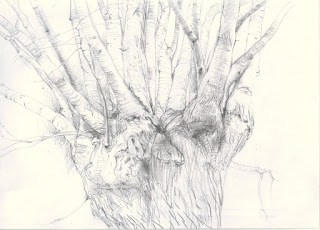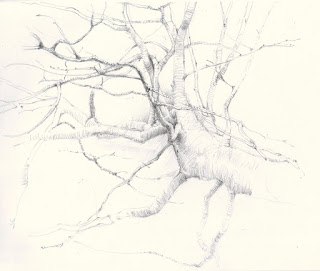
oil on canvas 51x51cm
At last. That’s it. Done.
This started off as a simple exercise in making a portrait from a photograph. That was in December 2008. Ah, So Long Ago. I’ve been hacking away at this on and off ever since (see ‘Works in Progress’), and you may remember the painted cellophane post of March 2010. If I ever do this again - and I probably will - I really must make sure that I have adequate source material to work from, and not a fuzzy and confused original that was badly printed and a bit too small.
Anyway. The source image is from some interesting Sydney police photos of the 1920’s and 30’s, before the mug shot was formalised. I was struck by Edith Stone’s photo because of the light, and the intensity and complexity of her expression. She looks stupid and desperate, but also submissive, as if playing for sympathy, but there seems to be an underlying coldness and anger. There is no indication on the original plate what her crime was – she could be a petty thief, prostitute, bank robber, or murderer – take your pick.
Compositionally, the collar and bobbed hair were a gift and there are some nice rhyming shapes in the hair, jaw and neckline, but I struggled a bit with the backdrop. Finally, out of desperation, I filled it in with featureless opaque Mars Black, which set off the rich transparent coloured blacks in the hair quite nicely. To distinguish the silhouette of the hair a bit more, I used the rough green edge from the March 2010 cell painting, which adds a little more drama very effectively. The paint surface on the figure is very rich - not surprising considering that’s it’s been re-worked on and off for two years.
There is a mood-setter track to go with this – ‘When you were young’ from Sam’s Town, by the Killers. It’s oddly melancholy for such a high-energy track. Oh look, here it is…
http://soundcloud.com/mtltim/the-killers-when-you-were-young
…and the rest of the album works too, if you have it.
Hopefully this has been a successful exercise. It was tempting to write this off when I plainly couldn’t make it work, but I find it difficult to let these things go unresolved. I actually had it almost beaten a couple of times, but it had slightly wrong resonances, and in trying to pin it down I ended up knackering it. Learning all the time, of course, so nothing’s really wasted. I think this is the nearest I’m going to get to reflecting the initial stimulus, so -
’Bye Edith… it’s been emotional.
At last. That’s it. Done.
This started off as a simple exercise in making a portrait from a photograph. That was in December 2008. Ah, So Long Ago. I’ve been hacking away at this on and off ever since (see ‘Works in Progress’), and you may remember the painted cellophane post of March 2010. If I ever do this again - and I probably will - I really must make sure that I have adequate source material to work from, and not a fuzzy and confused original that was badly printed and a bit too small.
Anyway. The source image is from some interesting Sydney police photos of the 1920’s and 30’s, before the mug shot was formalised. I was struck by Edith Stone’s photo because of the light, and the intensity and complexity of her expression. She looks stupid and desperate, but also submissive, as if playing for sympathy, but there seems to be an underlying coldness and anger. There is no indication on the original plate what her crime was – she could be a petty thief, prostitute, bank robber, or murderer – take your pick.
Compositionally, the collar and bobbed hair were a gift and there are some nice rhyming shapes in the hair, jaw and neckline, but I struggled a bit with the backdrop. Finally, out of desperation, I filled it in with featureless opaque Mars Black, which set off the rich transparent coloured blacks in the hair quite nicely. To distinguish the silhouette of the hair a bit more, I used the rough green edge from the March 2010 cell painting, which adds a little more drama very effectively. The paint surface on the figure is very rich - not surprising considering that’s it’s been re-worked on and off for two years.
There is a mood-setter track to go with this – ‘When you were young’ from Sam’s Town, by the Killers. It’s oddly melancholy for such a high-energy track. Oh look, here it is…
http://soundcloud.com/mtltim/the-killers-when-you-were-young
…and the rest of the album works too, if you have it.
Hopefully this has been a successful exercise. It was tempting to write this off when I plainly couldn’t make it work, but I find it difficult to let these things go unresolved. I actually had it almost beaten a couple of times, but it had slightly wrong resonances, and in trying to pin it down I ended up knackering it. Learning all the time, of course, so nothing’s really wasted. I think this is the nearest I’m going to get to reflecting the initial stimulus, so -
’Bye Edith… it’s been emotional.










.jpg)









